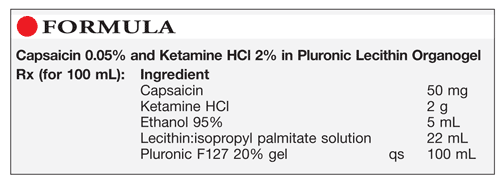US Pharm. 2011;36(5):39-40.

Method of Preparation: Calculate the quantity of each ingredient for the amount to be prepared. Accurately weigh or measure each ingredient. Mix the capsaicin and ketamine HCl with the ethanol. Incorporate the lecithin:isopropyl palmitate solution; mix well. Add the Pluronic F127 20% gel to volume; combine using a shear-mixing technique. Package and label.
Use: This preparation has been used to treat orofacial neuropathic pain.
Packaging: Package in tight, light-resistant containers.
Labeling: Shake well before taking. Keep out of the reach of children. Discard after 30 days.
Stability: A beyond-use date of 30 days may be used for this preparation.1
Quality Control: Quality-control assessment can include theoretical weight compared with actual weight, pH, specific gravity (SG), active drug assay, color, texture–surface, texture–spatula spread, appearance, feel, rheologic properties, and physical observations.1,2
Discussion: Capsaicin (C18H27NO3, MW 305.41), the dried ripe fruit of Capsicum frutescens Linné (Solonaceae), contains not less than 0.5% capsaicin. It is used as a topical analgesic in postherpetic neuralgia, diabetic neuropathy, osteoarthritis, rheumatoid arthritis, and muscular pain. An off-white powder that melts at about 65°C, it is soluble in alcohol and practically insoluble in cold water. It should be protected from light.1,3
Utilized as an anesthetic and analgesic, ketamine HCl (C13H16ClNO.HCl, MW 274.2) occurs as a white crystalline powder with a slight characteristic odor. Approximately 1.15 mg is equivalent to 1 mg ketamine base. It is soluble 1 g in 4 mL water, 14 mL alcohol, and 60 mL absolute alcohol. Ketamine HCl injection contains an amount of ketamine HCl equivalent to not less than 95.0% and not more than 105.0% of the labeled amount of ketamine. The injection has a pH of 3.5 to 5.5 and contains not more than 0.4 USP EU/mg ketamine HCl. Store at controlled room temperature and protect from light.1,3
Alcohol (ethyl alcohol, ethanol, grain alcohol, C2H5OH, MW 46.07) is a clear, colorless, mobile, volatile liquid with a slight, characteristic odor and a burning taste. It is used as an antimicrobial preservative (>10% concentration), disinfectant (60%-90% concentration), and solvent in injectable and oral liquids (variable concentration) and topical products (60%-90% concentration). Its SG is 0.812 to 0.816 and its boiling point is 78.15°C. It is miscible with chloroform, glycerin, and water; its solutions may be sterilized by autoclaving or filtration. It is incompatible with oxidizing materials in acidic conditions. With alkalies, it may darken in color. When it is added to aqueous solutions of organic salts or acacia, they may precipitate. It is incompatible with aluminum containers and may interact with some drugs.4 Store in a cool place.
Lecithin (egg lecithin, soybean lecithin, vegetable lecithin) describes a complex mixture of acetone-insoluble phosphatides consisting chiefly of phosphatidylcholine, phosphatidylethanolamine, phosphatidylserine, and phosphatidylinositol in combination with triglycerides, fatty acids, and carbohydrates. It is used as an emollient, emulsifying agent, and solubilizing agent in topicals, inhalation aerosols, parenterals, and oral suspensions. Lecithin from vegetable sources has a bland or nutlike taste and is brown to light yellow. It ranges from viscous semiliquids to powders and is practically insoluble in water, polar solvents, and cold vegetable and animal oils; when mixed with water, it hydrates to form emulsions. It is soluble in aliphatic and aromatic hydrocarbons, mineral oil, and fatty acids. It decomposes at extremes of pH, is hygroscopic, and is subject to microbial degradation. Store in well-closed containers and protect from light.5
Isopropyl palmitate (C19H38O2, MW 298.51) is a colorless, mobile liquid with a slight odor that is used as an emollient, oleaginous vehicle, and solvent; it has good spreading characteristics. It is soluble in acetone, alcohol, and castor, cottonseed, and mineral oils and is insoluble in water, glycerin, and propylene glycol. It is resistant to oxidation and hydrolysis and does not become rancid. Store in well-closed containers and protect from light.6
Poloxamers are a series of closely related block copolymers of ethylene oxide and propylene oxide that are used as emulsifying, solubilizing, and wetting agents. They are available in different grades, either liquids or solids, with an average molecular weight of 2,090 to 14,600. They are generally white, waxy, free-flowing granules or cast solids that are practically odorless and tasteless. The pH of a 2.5% w/v aqueous solution is 6.0 to 7.4. They are stable in the presence of acids, alkalis, and metal ions, but aqueous solutions support mold growth. Poloxamer 407 (Pluronic F127), which has a very mild or no odor, generally is available in powdered form and is freely soluble in water, alcohol, and isopropyl alcohol.
Note: When counseling the patient about this preparation, explain that its viscosity is temperature dependent. As the preparation is rubbed into the skin and warms up, it may become slightly more viscous and resistant to rubbing.7
REFERENCES
1. USP Pharmacists’ Pharmacopeia. 2nd ed. Rockville, MD: U.S. Pharmacopeial Convention Inc; 2008:1428, 1444.
2. Allen LV Jr. Standard operating procedure for performing physical quality assessment of ointments/creams/gels. IJPC. 1998;2:308-309.
3. Sweetman SC, ed. Martindale: The Complete Drug Reference. 37th ed. London, England: Pharmaceutical Press; 2011:33-34,1943.
4. Quinn ME. Alcohol. In: Rowe RC, Sheskey PJ, Quinn ME, eds. Handbook of Pharmaceutical Excipients. 6th ed. London, England: Pharmaceutical Press; 2009:17-19.
5. Sheng JJ. Lecithin. In: Rowe RC, Sheskey PJ, Quinn ME, eds. Handbook of Pharmaceutical Excipients. 6th ed. London, England: Pharmaceutical Press; 2009:385-387.
6. Taylor AK. Isopropyl palmitate. In: Rowe RC, Sheskey PJ, Quinn ME, eds. Handbook of Pharmaceutical Excipients. 6th ed. London, England: Pharmaceutical Press; 2009:350-351.
7. Collett JH. Poloxamer. In: Rowe RC, Sheskey PJ, Quinn ME, eds. Handbook of Pharmaceutical Excipients. 6th ed. London, England: Pharmaceutical Press; 2009:506-509.
To comment on this article, contact rdavidson@uspharmacist.com.





